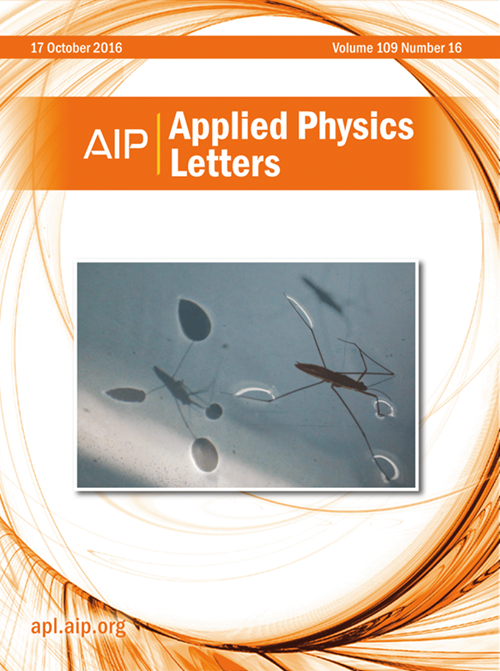Gate-Voltage modulated spin caloritronics in Fe/Cr-doped Janus MoSeTe nanoribbons
IF 3.5
2区 物理与天体物理
Q2 PHYSICS, APPLIED
引用次数: 0
Abstract
Conventional thermoelectric conversion based on charge transport faces significant challenges due to inherent limitations, such as a low power factor, inevitable Joule heating, and high thermal conductivity. To address these challenges, spin caloritronics offer a promising pathway for thermoelectric conversion based on the spin degree of freedom, which has attracted considerable interest because of its low energy consumption and high response speed. In this study, we systematically investigates the gate-voltage-tunable spin caloritronic properties of transition metal (Fe/Cr)-doped Janus MoSeTe nanoribbons through combined non-equilibrium Green's function and density functional theory. These results reveal that Cr-doped Janus MoSeTe devices demonstrate a perfect spin Seebeck effect with pure spin current under specific gate voltages. The Fe-doped system exhibits two negative differential thermal resistance peaks and achieves 100% thermal-driven spin polarization through effective spin filtering. Notably, both the magnitude and polarity of these negative differential thermal resistance peaks can be controlled via gate voltage, which is attributed to the fact that the gate voltage can modulate the spin-resolved transmission spectrum. Furthermore, these devices demonstrate a significant spin figure of merit (ZTsp,max∼ 42) near the Fermi level at T = 300 K. These findings highlight the potential for developing high-efficiency spin caloritronic devices and thermal management applications utilizing Fe/Cr-doped MoSeTe nanoribbons under a specific gate voltage.掺铁/铬Janus MoSeTe纳米带的门电压调制自旋热电子
由于固有的局限性,传统的基于电荷输运的热电转换面临着巨大的挑战,例如低功率因数、不可避免的焦耳加热和高导热性。为了解决这些挑战,自旋热电子为基于自旋自由度的热电转换提供了一种有希望的途径,由于其低能耗和高响应速度而引起了相当大的兴趣。本研究通过结合非平衡格林函数和密度泛函理论,系统地研究了过渡金属(Fe/Cr)掺杂Janus MoSeTe纳米带的门电压可调自旋热电子特性。这些结果表明,在特定栅极电压下,掺杂cr的Janus MoSeTe器件表现出完美的自旋塞贝克效应,具有纯自旋电流。掺铁体系表现出两个负差热阻峰,并通过有效的自旋滤波实现了100%的热驱动自旋极化。值得注意的是,这些负微分热阻峰的幅度和极性都可以通过栅极电压来控制,这是由于栅极电压可以调制自旋分辨透射谱。此外,这些器件在T = 300 K时在费米能级附近显示出显著的自旋值(ZTsp,max ~ 42)。这些发现突出了在特定栅极电压下利用Fe/ cr掺杂MoSeTe纳米带开发高效自旋热电子器件和热管理应用的潜力。
本文章由计算机程序翻译,如有差异,请以英文原文为准。
求助全文
约1分钟内获得全文
求助全文
来源期刊

Applied Physics Letters
物理-物理:应用
CiteScore
6.40
自引率
10.00%
发文量
1821
审稿时长
1.6 months
期刊介绍:
Applied Physics Letters (APL) features concise, up-to-date reports on significant new findings in applied physics. Emphasizing rapid dissemination of key data and new physical insights, APL offers prompt publication of new experimental and theoretical papers reporting applications of physics phenomena to all branches of science, engineering, and modern technology.
In addition to regular articles, the journal also publishes invited Fast Track, Perspectives, and in-depth Editorials which report on cutting-edge areas in applied physics.
APL Perspectives are forward-looking invited letters which highlight recent developments or discoveries. Emphasis is placed on very recent developments, potentially disruptive technologies, open questions and possible solutions. They also include a mini-roadmap detailing where the community should direct efforts in order for the phenomena to be viable for application and the challenges associated with meeting that performance threshold. Perspectives are characterized by personal viewpoints and opinions of recognized experts in the field.
Fast Track articles are invited original research articles that report results that are particularly novel and important or provide a significant advancement in an emerging field. Because of the urgency and scientific importance of the work, the peer review process is accelerated. If, during the review process, it becomes apparent that the paper does not meet the Fast Track criterion, it is returned to a normal track.
 求助内容:
求助内容: 应助结果提醒方式:
应助结果提醒方式:


